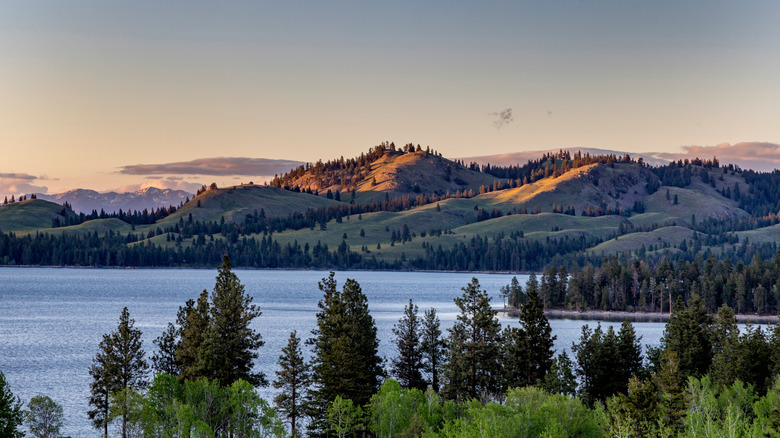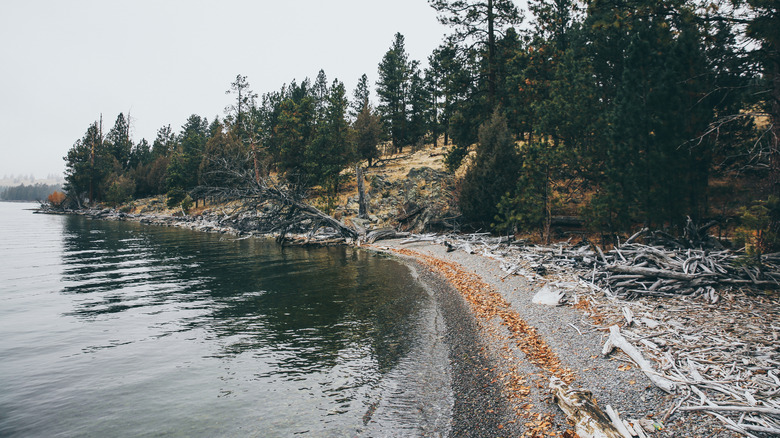Wildlife Thrives On This Serene Montana Island Fringed By Hiking Trails And Picturesque Paddling
When it comes to the Big Sky Country of Montana, it's usually the state's rugged and wild mountain regions that lead the way for adventure-hungry travelers — here's looking at you, Glacier National Park, the so-called "Crown of the Continent." But there are other joys, including the largest freshwater lake this side of the Mississippi River and the wildlife-rich island that pops up right in the middle of it. It goes by the name of Wild Horse Island, and it abounds with birdwatching, boating, kayaking, hiking, and a whole load more.
Wild Horse is the largest island on Flathead Lake, and is mostly encompassed by the Wild Horse Island State Park. It offers a rare example of a prairie ecosystem more commonly found amid the lush, rolling hills of southeastern Washington's Palouse region. That means high mounds of grasses that sway in the winds with ancient groves of ponderosa pines scattered throughout, and glimpses of all sorts of fauna — from bald eagles to bears to genuinely wild horses.
You'll need to summon your water legs to get across to Wild Horse Island. The state park can only be accessed by watercraft, and there are six marked landing spots peppering all sides of the rock, from Osprey Cove in the east to Rocky Bar in the west. The trip is doable in a kayak from the town of Dayton on the Montana mainland, while outfitters offer motorboat taxis to the island from the quays of Big Arm. The nearest airport is just up the road, around an hour's drive away in Kalispell.
What puts the 'wild' in Wild Horse Island?
One of the main attractions of Wild Horse Island is the unique array of critters that make their home here. Most notably, there's the creature that gives the isle its name: A handful of truly feral horses that roam the grassy meadows and woods. They've been about since the days when the Kootenai Indians raised their horses on these shores, apparently to deter raiders and rustlers from other tribes.
These days, the herd is managed by the Montana wildlife authorities, and lucky hikers can spot them moving between the orchards and open spaces. You can up your chances of seeing the iconic equine inhabitants by following trails that go between the fruit trees (where they often head in search of food) and getting to the island nice and early (when wildlife viewing is prime).
No horses? No problem! There's a whole kaleidoscope of other quintessential Montana fauna to spot in these parts. Across the 2,100-plus acres of the island, bighorn sheep combine with mule deer to offer potential encounters with big ground mammals. Meanwhile, in the skies overhead, bald eagles patrol the windways and ospreys fly above the ponderosa groves. And that's not even mentioning the vibrant flower displays of lilies and brush that bloom in earnest with the coming of spring.
Hoofing the trails and paddling the coves on Wild Horse Island
Wild Horse Island might not have the abundance of rugged hiking trails found in Eureka, or the uber-busy Avalanche Trail of the Glacier National Park, but there's still some downright lovely walking to be had between its pretty prairies and rocky shores. There are two marked loops on the isle, conveniently called the Trail 1 Loop and the Trail 2 Loop.
They both connect at the popular landing point of Skeeko Bay on the north shore before veering southward into the interior. You can combo the two together to get a 3.1-mile hike that showcases the essence of the island. One former hiker on AllTrails summed up their outing like this: "Very cool trail. The scenery is breathtaking on a clear day. We saw [bighorn sheep], mule deer and horses. I would suggest bringing binoculars, as many places in the trail give you views of large expanses in the distance where wildlife may be grazing."
One thing to note: Wild Horse is a seriously large island. The marked hiking paths cover just a portion of the western coast. The upshot? Much of the eastern coast is only accessible by boat. Pockmarked with pull-ins for kayakers, you can stop to explore driftwood-strewn pebbles and craggy shoreline and to spot the herds of resident bighorn sheep.


